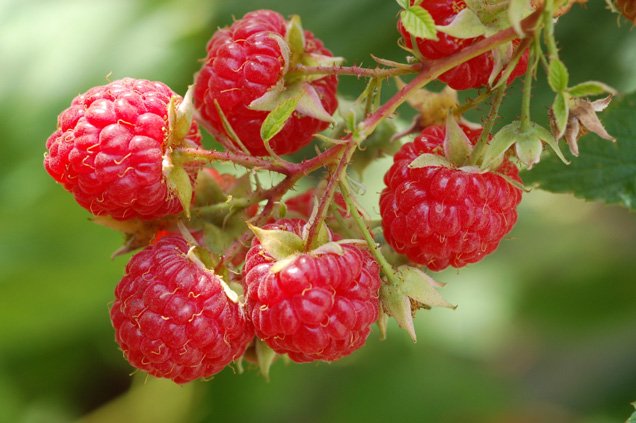The raspberry is the edible fruit of a multitude of plant species in the genus Rubus of the rose family, most of which are in the subgenus idaeobatus; the name also applies to these plants themselves.
-ETYMOLOGY-
Raspberry derives its name form raspise " a sweet rose-colored wine"(mid 15-th Century),from the Anglo-Latin vinum raspise or from raspoie meaning "thicket" of Germanic origin.The name may have been influenced by its appearence as having a surface related to Old English rasp or "rough berry".
-SPECIES-
Examples of raspberry species in Rubus subgenus idaeobatus include:
*Rubus crataegifolius(Asian raspberry)
*Rubus gunnianus(Tasmanian alpine raspberry)
*Rubus leucodermis(Whitebark or Western raspberry,Blue raspberry,Black raspberry)
*Rubus occidentalis(Black raspberry)
*Rubus parvifolius(Australian native raspberry)
*Rubus phoenicolasius(Wine raspberry or Wineberry)
*Rubus rosifolius(Mauritus raspberry)
*Rubus strigosus(American red raspberry)
*Rubus ellipticus(Yellow Himalayan raspberry).
-CULTIVATION-
Various kinds of raspberries can be cultivated from hardiness zones 3 to 9.Raspberries are traditonally planted in the winter as dormant canes,although planting of tender, plug plants produced by tissue culture has become much more .A specialized production system called "long cane production" involves growing canes for a year in northern climate such as Scotland or Oregon or Washington,where the chilling requirement for proper bud break is attained,or attained earlier than the ultimate place of planting.These canes are the dug,roots and all,to be replanted in warmer climate such as Spain,where they quickly flower and produce a very early season crop.Plants a re typically planted 2-6 metters in fertile,well drained soil;raspberries are usually planed in raised beds/ridges,if there is any question about root problems.The flowers can be a major nectar source for honeybees.
Raspberries are very vigorous and can be locally invasive.They propagate using basal shoots(also known as suckers) extended underground shoots that develop roots and individual plants.They can sucker new canes some distance from th main plant.For this reason ,Raspberries spread well and can take over gardens if left unchecked.The fruit is harvested when it comes off the receptable easily and has turned a deep color(red,black,golden yellow,depending on the species and cultivar).
-Major Cultivar-
Raspberries are an important commercial fruit crop,widely grown in all temperate regions of the world.
Many of the most important modern commercial red raspberry cultivars derive from hybrides between R. idaeus and R. strigosus.Some botanists consider the Eurasian and American red raspberries to belong to a single,circumboreal species.
The black raspberry R. occidentalis is also cultivated.providing both fresh and frozen fruit,as well as jams,preserves and other products all with that species distinctive flavor.
Purple raspberries have been produced by horticultural hybridization of red and black raspberries,and have also been found in the wild in afew places(In Vermont) where the American red and black raspberries both grow naturally.
-FRUIT-
Raspberries are grown for the fresh fruit market and for commercial processing into individually quiuck frozen fruit(IQF), as juice or as dried fruit,used in a variety of grocery products .Traditionally raspberries, were a midsummer crop,but with new technology,cultivars and transportation,the can now be obtained year-round.Raspberries need water and sun for development.Raspberries thrived in well-drained soil with a pH between 6 and 7 ample organic matter to assist in retaining water.While moisture is essential,wet and heavy soils or exess irrigation can bring on Phytophthora root rot,which is one of the most serious pest problems facing the red raspberry.As a cultivated plant in moist,temperate regions,it is easy to grow tendency to spread unless pruned.

-NUTRIENTS-
Raw raspberries are 86% water,12% carbohydrates,and have about 1% each protein and fat table.In a 100g amount raspberries supply 53 calories.
The aggregate fruit structure contributes to raspberry's nutritional value as it increases the proportion of dietary fiber,which is among as the highest known in whole foods,up to 6% fiber per total weight.Raspberries are a rich source (20% or more of the daily value DV)(of vitamin C 32% DV),(manganese 32% DV),(and dietary fiber 26% DV).Raspberries are a low-glycemic,index-food, with total sugar content of only 4% and no starch.
Hmmm...a quick, rinse, sugar sprinkle, bowl and a spoon...and your away. They look delicious thank you for sharing @visar197
Downvoting a post can decrease pending rewards and make it less visible. Common reasons:
Submit
Source: https://en.wikipedia.org/wiki/Raspberry
Not indicating that the content you copy/paste is not your original work could be seen as plagiarism.
Some tips to share content and add value:
Repeated plagiarized posts are considered spam. Spam is discouraged by the community, and may result in action from the cheetah bot.
Creative Commons: If you are posting content under a Creative Commons license, please attribute and link according to the specific license. If you are posting content under CC0 or Public Domain please consider noting that at the end of your post.
If you are actually the original author, please do reply to let us know!
Thank You!
Downvoting a post can decrease pending rewards and make it less visible. Common reasons:
Submit
May be you like this paper: Analysis of the expression of β-actin, RuANS and RuMYB10 genes involved in the biosynthesis of anthocyanin using RT-qPCR in Rubus niveus in the Rumiñahui Canton
You can read it in the next link http://content.iospress.com/articles/journal-of-berry-research/jbr156
Downvoting a post can decrease pending rewards and make it less visible. Common reasons:
Submit